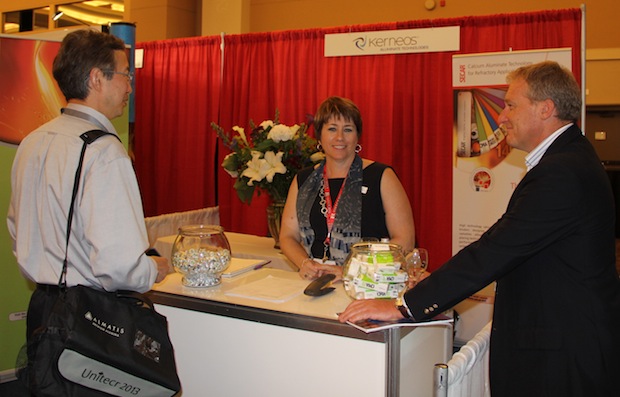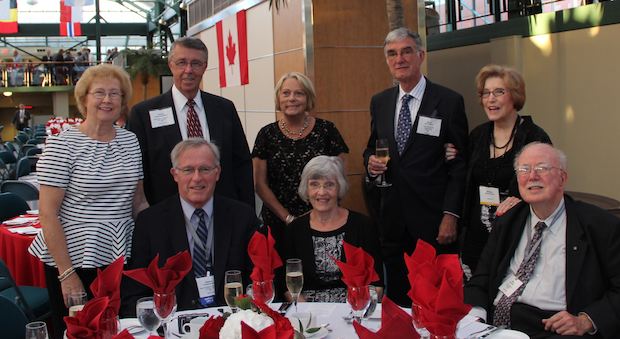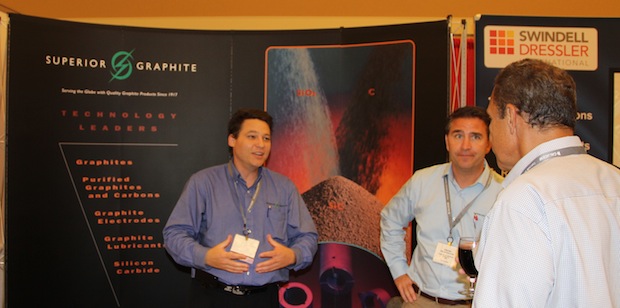
Last week I shared several of the images I collected at the Unitecr conference in Victoria, BC, Canada. (See the end of today’s post for more.) I did not visit many technical sessions, but I learned a lot from the keynote and plenary speakers and from talking to people. Today I’ll share with you my “top ten takeaways,” or TTT (with a wink to my metallurgist readers).
The organizers of last week’s Unitecr meeting were savvy in their choice of keynote and plenary speakers, choosing a refractory raw material supplier, a steelmaker, and a renowned consultant to the global refractories industry. In order, the speakers were Remco De Jong, Refractory Minerals Division, Imerys; Tom Vert, ArcelorMittal Dofasco; and Charles Semler, Semler Materials Services. As the three speakers outlined their views of the refractory industry from their unique perspectives as a supplier, a consumer, and an advisor, some consistent themes emerged that, in a way, come down to time, temperature, and transformation. The steel industry especially has seen enormous shifts over the last decade as the global economy heats up and cools down and flares in certain regions.
The conference attracted 630 attendees. Here are my thoughts with the caveat that I am just a visitor to the refractories world. Its citizens surely took away different points, depending on their own perspectives.
1. Steel is big business and the refractory industry’s biggest customer. Therefore, as goes the steel business, so goes the refractory business. How big is the steel industry? Vert, Thursday’s plenary speaker and general manager of primary manufacturing for ArcelorMittal Dofasco, says about 60 percent of all refractories are sold to the primary steelmaking industry and that refractory sales in 2012 were $1.1 billion. Sixty percent of a billion is a lot of refractories. Other industries that consume significant refractory materials are the nonferrous metals industries, especially aluminum; cement; and glass manufacturers.
2. Global trends dominate the steel industry’s ability to do business. And by “global trends,” I mean the effect of China’s steel industry on the rest of the world. According to Vert, steel production in China increased by 400 percent in the last decade, and the country has built 100 new steel plants in the last dozen years. Consequently, China makes as much steel as the rest of the world combined. De Jong, Wednesday’s keynote speaker and vice president of refractory raw minerals for Imerys, cited World Steel Association statistics that say the same thing: in 2002 China manufactured 21 percent of world crude steel; by 2012 that amount increased to 47 percent. According to De Jong, the Chinese growth rate finally is slowing down. (He says similar trends are evident in the country’s aluminum refining industry, too.)
3. Overcapacity plagues the steel industry, according to both De Jong and Vert. The situation came about because of government-backed steel mill building in China, which effectively eliminates barriers to entry. Estimates are that the excess capacity is in the 10–15 percent range. Vert observed that exiting the steel industry is not necessarily so easy because the loss of jobs and the resulting hit to a local economy can trigger unrest and political interventions.
4. Steelmakers do not have many places to look for cost control, according to steelman Vert, who quoted a recent article in The Economist: “Steelmaking scrapes by on microscopic margins that make even airlines look like paragons of productivity.” Vert says most steelmaking costs—labor, space, repair and maintenance, etc.—are fixed. Variable costs include fuel and refractories. Overall, refractories contribute about 2–3 percent of the cost of steel.
5. Steelmakers are risk-averse, so they do no change refractory suppliers often. However, when they do, they are looking for lower cost, of course, but also higher value, which Vert described as “solutions, not products.”
6. Steelmakers tend to view refractory products as commodities rather than as engineered ceramics, and thus work to exert downward price pressure on suppliers. Refractory suppliers are complicit in perpetuating this by the way they do business. Traditionally, for example, sales representatives focused on price and relationships to win sales, rather than promoting data-driven purchasing decisions. Vert and Semler both lamented that technical data sheets from many refractory companies include very little useful data, and just about no data for properties at service temperatures.
7. All three speakers addressed the “refractory as commodity vs engineered ceramic” issue. De Jong emphasized the need for raw materials suppliers and refractory companies to be adaptable. An emerging trend is recycling of refractories and sustainable use of materials. Picking up on the idea of engineered ceramics, Vert imagines the possibility of functional refractories—for example, materials that are not just inert to molten steel but are capable of helping to clean the steel.
8. All three speakers also called for the refractory community to develop new products, recognizing that there are some significant challenges. Vert cited a case of a project to develop a new ladle mortar that took a full two years. A critical piece of developing new engineered refractory solutions is to develop new tests that accurately predict performance in service, i.e., at temperature. Apparently, there is a dearth of such tests and associated data.
9. Finding and developing talent was a common theme. Some companies solve the problem by hiring materials science and engineering graduates and teaching them the ceramic engineering themselves or by assigning mentors. Resources for training such as FIRE, Germany’s ECREF, ACerS’ Refractory Ceramics Division, and similar organizations elsewhere help fill the void. Returning to the theme of useful data sheets, Vert astutely observed, “If you provide a data sheet that only a ceramic engineer can read, steelmakers would hire ceramic engineers.”
10. Semler, who as a consultant has his finger on the pulse of the steel industry everywhere, sees ample R&D opportunity for new ways of thinking about refractories, such as bendable, flexible refractories, self healing refractories, filtering for inclusion reduction, recycled materials, nanotechnology applications, hot testing and modeling, and more. He repeated Vert’s call for data sheets with useful (i.e., at-temperature) data. Picking up on a theme from the NSF Grand Challenges workshop in 2012, he noted that new characterization tools make research possible today that could not have been done as recently as 15 years ago, which opens the door to developing solutions rather than products and backs the claim that refractories are engineered ceramics rather than commodities.
10-again. Finally, the refractories community is a great group of people to spend a week with!
Here are a few more scenes from Unitecr 2013. The 14th Unitecr, organized by the German Refractories Association, is scheduled for Sept. 15–18, 2015 in Vienna, Austria.

Nancy Bunt and Dana Goski pull names for door prizes at the Unitecr closing lunch on Friday. Credit: Frignon; ACerS.

“Refractory Engineers Hall of Fame” (editor’s description) at the Unitecr banquet with their wives. Back row, left–right): Darlene Semler, Jim Houseman, Beverly Houseman, Gene Dixon, Barbara Dixon. Seated, left–right: Charlie Semler, Elizabeth Bradt, Dick Bradt. Credit: ACerS.






